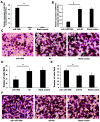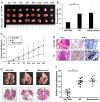MicroRNA‑190b expression predicts a good prognosis and attenuates the malignant progression of pancreatic cancer by targeting MEF2C and TCF4
- PMID: 34779502
- PMCID: PMC8600408
- DOI: 10.3892/or.2021.8223
MicroRNA‑190b expression predicts a good prognosis and attenuates the malignant progression of pancreatic cancer by targeting MEF2C and TCF4
Abstract
MicroRNAs (miRNAs/miRs) are key components of regulatory networks in cancer. Although miR‑190b is an important tumor‑related miRNA, its role in pancreatic cancer has not been extensively investigated. The aim of the present study was to examine the expression of miR‑190b in pancreatic cancer cell lines and tissues and evaluate its effects on cancer progression. Reverse transcription‑quantitative PCR (RT‑qPCR) analysis was used to measure miR‑190b expression levels in human pancreatic cancer cell lines and tissues, and the association between miR‑190b expression and clinicopathological characteristics was assessed. An in vitro Transwell invasion assay and an in vivo metastasis formation assay were performed using pancreatic cancer cells. The effect of miR‑190b on pancreatic cancer cell proliferation was evaluated using a Cell Counting Kit‑8 assay based on an in vivo xenograft mouse model. The direct targets of miR‑190b were predicted using bioinformatics tools and were validated through western blotting and luciferase reporter assays. Pancreatic cancer cell lines and tissues were found to express lower levels of miR‑190b compared with normal cells and adjacent non‑tumor tissues. Furthermore, high expression of miR‑190b was found to be positively correlated with low T, N and American Joint Committee on Cancer classifications, and predicted a good prognosis. miR‑190b was shown to exert suppressive effects on cancer cell proliferation, invasion and metastasis. In addition, it was also found that miR‑190b directly targeted myocyte enhancer factor 2C (MEF2C) and transcription factor 4 (TCF4) in pancreatic cancer, thus serving as a tumor suppressor and a predictor of good prognosis in pancreatic cancer. The immunohistochemistry and RT‑qPCR results indicated that the MEF2C and TCF4 expression levels were negatively correlated with the miR‑190b expression levels. The findings of the present study highlight the value of miR‑190b as a novel target candidate for pancreatic cancer diagnosis and therapy.
Keywords: microRNA‑190b; myocyte enhancer factor 2C; pancreatic cancer; prognosis; transcription factor 4; tumor suppressor.
Conflict of interest statement
The authors declare that they have no competing interests.
Figures







Similar articles
-
Downregulation of circulating miR 802-5p and miR 194-5p and upregulation of brain MEF2C along breast cancer brain metastasization.Mol Oncol. 2020 Mar;14(3):520-538. doi: 10.1002/1878-0261.12632. Epub 2020 Feb 5. Mol Oncol. 2020. PMID: 31930767 Free PMC article.
-
Methylation‑associated silencing of miR‑638 promotes endometrial carcinoma progression by targeting MEF2C.Int J Mol Med. 2020 Jun;45(6):1753-1770. doi: 10.3892/ijmm.2020.4540. Epub 2020 Mar 16. Int J Mol Med. 2020. PMID: 32186750 Free PMC article.
-
The interaction between miR‑148a and DNMT1 suppresses cell migration and invasion by reactivating tumor suppressor genes in pancreatic cancer.Oncol Rep. 2018 Nov;40(5):2916-2925. doi: 10.3892/or.2018.6700. Epub 2018 Sep 12. Oncol Rep. 2018. PMID: 30226601
-
MicroRNA‑766 inhibits the malignant biological behaviours of pancreatic ductal adenocarcinoma by directly targeting ETS1.Mol Med Rep. 2019 Feb;19(2):1380-1387. doi: 10.3892/mmr.2018.9770. Epub 2018 Dec 14. Mol Med Rep. 2019. PMID: 30569091
-
Long non-coding RNA PXN-AS1 suppresses pancreatic cancer progression by acting as a competing endogenous RNA of miR-3064 to upregulate PIP4K2B expression.J Exp Clin Cancer Res. 2019 Sep 5;38(1):390. doi: 10.1186/s13046-019-1379-5. J Exp Clin Cancer Res. 2019. PMID: 31488171 Free PMC article.
Cited by
-
TCF4 Promotes Neuroblastoma Proliferation and Inhibits Ferroptosis by Transactivating GPX4 Expression.Appl Biochem Biotechnol. 2025 Jul 16. doi: 10.1007/s12010-025-05329-7. Online ahead of print. Appl Biochem Biotechnol. 2025. PMID: 40668527
-
MicroRNAs and long non-coding RNAs in pancreatic cancer: From epigenetics to potential clinical applications.Transl Oncol. 2023 Jan;27:101579. doi: 10.1016/j.tranon.2022.101579. Epub 2022 Nov 1. Transl Oncol. 2023. PMID: 36332600 Free PMC article.
References
-
- Candido S, Abrams SL, Steelman LS, Lertpiriyapong K, Martelli AM, Cocco L, Ratti S, Follo MY, Murata RM, Rosalen PL, et al. Effects of the MDM-2 inhibitor Nutlin-3a on PDAC cells containing and lacking WT-TP53 on sensitivity to chemotherapy, signal transduction inhibitors and nutraceuticals. Adv Biol Regul. 2019;72:22–40. doi: 10.1016/j.jbior.2019.03.002. - DOI - PubMed
MeSH terms
Substances
LinkOut - more resources
Full Text Sources
Other Literature Sources
Medical

